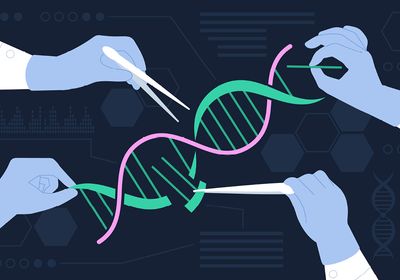Many species undergo programmed DNA elimination, a process where specific parts of the genome found in the original sperm and egg cells are removed from the cells of the developing body. Different species use varied cellular mechanisms to remove specific parts of their genomes. This process has recently been documented in worms in the Mesorhabditis genus, which eliminate approximately thirty percent of their DNA.1
Early in the process of Mesorhabditis development, cells still carry the germline genomes from the gametes that produced the first cell. As early as the two or four-cell stage, the DNA begins to fragment. Researchers can see this under a microscope, and it’s one of the first signs that a cell might be preparing for programmed DNA elimination. |  |
As the cells prepare to divide, the DNA assembles into chromosomes. Normally, microtubules latch onto these chromosomes via each chromosome’s kinetochore proteins. However, some DNA fragments lack kinetochores, so the microtubules have nowhere to bind. | |
The chromosomes arrange themselves in pairs along the middle of the dividing cell in a region called the metaphase plate. Without microtubules to guide them there, the unattached DNA fragments do not migrate to the metaphase plate and instead linger in the surrounding areas of the cell. They will likely be targeted for elimination. | |
In the last stage of cell division, the microtubules pull the pairs of chromosomes apart, so that each new cell’s nucleus gets one chromosome from each pair. The unattached DNA fragments remain in the center of the dividing cell, where they will be randomly pushed into one of the two new cells. |  |
Each new cell’s nucleus contains one full copy of the somatic genome, while the other DNA fragments remain in the cytoplasm outside the nucleus. Other species such as sea lampreys eliminate whole chromosomes instead of DNA fragments.2 During cell division, these chromosomes migrate to the metaphase plate along with the other chromosomes, but do not migrate to the poles of the dividing cell. This behavior is known as “lagging” and causes the chromosomes to be excluded from the new cells’ nuclei and eliminated. | |
After a few more cycles of cell division, the DNA excluded from the nucleus likely degrades in the cytoplasm, as seen in other worms.3 |
References
- Rey C, et al. Programmed DNA elimination in Mesorhabditis nematodes. Curr Biol. 2023; 33(17):3711-3721.
- Smith JJ, et al. Programmed DNA Elimination in Vertebrates. Annu Rev Anim Biosci. 2021; 9:173-201.
- Wang J, et al. Comprehensive Chromosome End Remodeling during Programmed DNA Elimination. Curr Biol. 2020; 30(17):3397-3413.
Read the full story.






